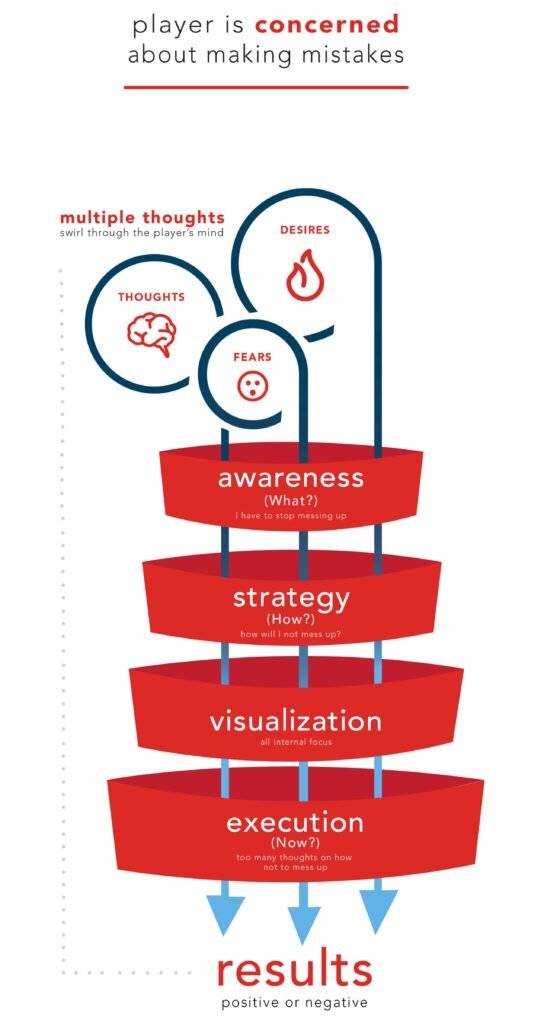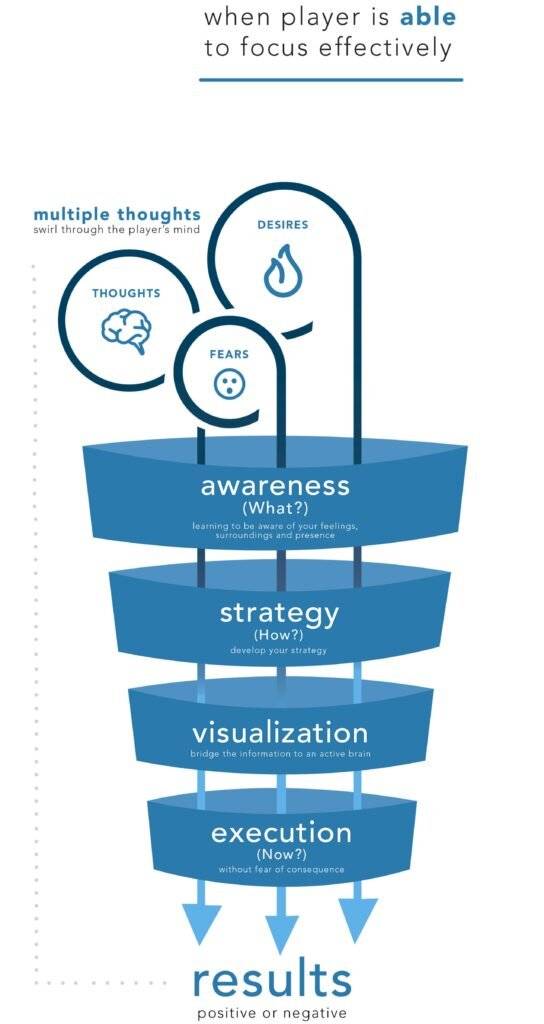
Bhrett McCabe
The Funnel of Focus
Your ability to focus is independent of the clutter, chaos, and drama of your day. There are days when it’s aligned and beneficial for performance, and there are other days when it’s scattered, counterproductive, and energy-consuming. Let’s first consider the athlete who is functioning in a world of chaos and drama, and despite the distractions, is trying hard to perform well.
Regardless of the sport, as an athlete approaches the execution phase, there are several steps at work. Athletes who are distracted by the chaos of life and competition fall victim to the Inverse Funnel Effect. Instead of their focus working for them on an external target, it actually works against them by concentrating on internal processes and, most importantly, survival.
"The power to accept ultimately means accepting who you are and having confidence that you can work through any situation in which you find yourself – basically, that you’re okay, regardless of your circumstances as a person, athlete, or competitor."
Where Focus is the Strongest
Focus is the strongest at the first phase: Awareness. This is the ability of the athlete to examine and experience the moment without judging or labeling. Unfortunately, when an athlete is struggling or in an intense environment, the awareness phase of the funnel is actually where the most energy is directed because the athlete is in survival mode. The goal becomes simply to survive the challenge, not thrive in it. When survival is the goal, the mind recruits all of its available resources and energy to find safety. This is hardwired into us and is commonly referred to as the “fight or flight” response. The underlying sympathetic nervous system has always had one primary job: survival.
But in today’s world, although our hardwiring is the same, most of the threats that required such a sensitive and aggressive system when the earliest humans roamed the earth are no longer present. For that reason, the fight-or-flight response system over-interprets and overreacts, although it’s still just doing the job for which it was designed.
When an athlete is in a stressful period or struggling with performance, the awareness phase is in full protection mode – it’s primarily on guard against ego hits and even greater struggles. As a result, much of the player’s focus is taken away from the process or the desired outcome and is spent instead on protection. That changes everything.
When this change occurs, it starts with the Strategy phase. Everything we do in life and in sport has intent or purpose that, if executed properly, will match the desired outcome. Our strategy is how we intend to execute our game plan. When Awareness is in protection mode, the strategy is no longer about execution for purpose, but rather, for protection. And too many athletes play in this mode far too often.
Regardless of the sport, the ability to define a strategy with intent and purpose is important. If a player is functioning in chaos and drama and he or she has reverted to the protective mindset, it’ll be hard to change the strategy. It’s just difficult for people to commit aggressively to strategy when their mindset is trying to protect them.
When the funnel is inverted, the focus starts to widen as it moves from the narrow point at the Awareness end and outward toward Execution. This wider focus as the execution phase approaches allows the athlete to start searching for solutions and quick fixes and to scan their internal processes. This is why the harder a struggling athlete tries to be more mechanical, the worse things get. It’s only when they stop trying to be mechanical that they find their mechanical freedom.
An inverted funnel results in desperate searching, the loss of confidence, an overly internal focus, and often more chaos. You can see it in the face of the athlete caught in the throes of an inverted funnel: they’re exasperated, frustrated, and, sometimes, just look like they no longer care. But the opposite is usually the case – they care a lot, but at that moment they care a lot more about protecting themselves from the pain.
When an athlete is playing through the Funnel of Focus, focus flows from wide to narrow – from Awareness through Execution – to provide the desired results. On each shot, each pitch, each play, their focus is actively reset to a proper funnel, which is a powerful mechanism to use to move through the indecisions and frustrations of a chaotic environment.


Awareness functions best when it accepts experiences without judgment or reaction. It is important to understand that thoughts, emotions, the chaos of life, and external influences are around us in every experience and that they’re relatively harmless until we assign them meaning or value.
Imagine driving down the road and seeing a car accident. You pull up and see a sixteen-year-old teenager standing outside the car. Without any other information, you’re likely to have a variety of passing thoughts, perhaps including “I would hate to be their parent right now,” or “They’re probably lucky they didn’t kill someone – you know how teenagers drive.” But those thoughts actually mean nothing, and you’re not wrong for thinking them.
What Are Thoughts, Really?
Thoughts are random words and sentences that flow through your consciousness. I like to think of them as test balloons from that little voice deep inside you, the one that likes to see if this thought or that thought can elicit a response or emotion from you. Under stress, these thoughts tend to center around fear, stress, and the struggle. In a chaotic world, thoughts tend to be influenced by the angst and chaos of the environment.
Awareness is ultimately acceptance – acceptance that you’re okay regardless of the chaos, fears, doubts, and struggles that you’re facing. In fact, acceptance is probably the engine behind the effective Awareness that keeps the funnel in the proper form. Without acceptance, awareness is more akin to vigilance. The fight-or-flight instinct only kicks in when we’re aware that something may be a threat – hence the analogy to vigilance.
The power to accept ultimately means accepting who you are and having confidence that you can work through any situation in which you find yourself – basically, that you’re okay, regardless of your circumstances as a person, athlete, or competitor. If it were only that easy!
If you want to freak someone out, put them in front of a mirror. This definitely demands acceptance. Most of us live in a fairy-tale world, with an often distorted image of who and what we’ve been, who and what we truly are at the present time, and what we’ll become. It’s an amazing coping mechanism that allows us to continually attempt to create a new, more successful future for ourselves. Not surprisingly, however, it’s also often impossible and inaccurate.
The mirror doesn’t lie or distort. It shows you exactly what you are at that moment. It’s the truth that we all fear and try to suppress. But the only way to make peace with the mirror is to accept, and acceptance is probably the hardest thing that any of us have to do. It requires us to let go of the past and resist the temptation to seduce the future. Acceptance requires honesty and vulnerability. And as painful as it can be, it also fuels success. When we learn to accept who we are, then we can start growing.
To understand awareness and acceptance, you need to grasp that idea that regardless of circumstance and regardless of the challenge, the most significant factor in the equation is you. For an athlete to compete at their best and do so with a funnel that is upright and working for them, he or she must accept and be aware that the challenges of the moment aren’t determining their effort or outcome. At the top of the funnel, an open and accepting awareness state allows positive and negative thoughts to move through the consciousness without attachment or labels. If a golfer is concerned about hitting a bad shot, the sudden thought that he or she had better not hit any more bad shots can definitely have an impact on the player. But if their acceptance and awareness is working for them, that thought can move on without impact, a sign that they trust the process and engagement of the funnel.
Moving to Strategy
From an upright funnel, awareness moves to a strategy. No longer about prevention of outcomes, a player who accepts the chaos and intensity of the moment is no longer worried about preventing any outcomes, and he or she understands that the strategy they choose should only be about intent and purpose. If you’re going to jump out of an airplane, the strategy should be to jump and effectively deploy the parachute, not hope you survive. Since a strategy is best devised from a mindset of purpose, it should be based on your strengths, not an avoidance of your weaknesses.
An effective strategy should balance the odds of success with the level of commitment to that strategy. The decision with the best odds may not be the easiest to commit to during the heat of competition.
Athletes often have the urge to get out of the box and be a bit more aggressive. That’s not necessarily a bad strategy, as long as the decision and outcome, whatever they are, can be fully accepted. Arm-chair quarterbacking is never productive. The biggest question about a using a particular strategy shouldn’t be how successful it might be, but rather, how committed you are to the decision to use it.
When the funnel is at risk of turning to the inverse position, the strategy and commitment to it can eroded by doubt, which once again feeds the chaos around you. Commitment requires that you buy in to the plan and ultimately trust it. Once again, it requires acceptance. When an athlete is starting to feed into the chaos and doubts, that acceptance gives away to fear, arm-chair quarterbacking, and a dramatic shift in focus.
Focus isn’t about ignoring anything, it’s about becoming so locked in on one thing that nothing else matters. Commitment is when the focus is external on the target and the acceptance of the outcome is high. That’s when focus becomes intense.
Once the strategy is determined, and the funnel is upright, it’s easy to visualize the action. Visualization is the bridge from planning to execution. Visualization is the ability to see the action before the action occurs, not by magic or foretelling, but by creating the desired movie script. There are times when focus is heightened and visualization is easy, but that’s not usually the case. In fact, visualization is a skill that should be developed long before it’s ever tested in a competitive environment. The ability to focus on the abstract idea of a shot, a pitch, a game, or a race isn’t an inherently easy thing to do, primarily because the mind wants to clutter the solitude necessary to visualize effectively.
When the mind sees the intended action with the focused intent, it serves as a rehearsal of positive intent. True visualization should be broken down into two categories: practiced meditation visualization, and active engagement activity visualization.
Practiced meditation visualization is done away from competition while working on relaxation strategies and the meditative mindset. Essentially, you’re trying to build the practice to enhance the skill when called upon in competition.
Active engagement activity visualization is visualization that takes place at the moment of action and is so important to a proper funnel of focus. This type of visualization is simply seeing the action you intend to take in a positive, engaged, and active manner. It can be anything that’s visualized about the desired outcome: for example, something concrete, like the ball actually going through the net; or something more abstract, like the desired trajectory of your shot passing through an imaginary window that represents the trajectory of a shot. In either case, you should be visualizing the final result or feeling, never the mechanics that produce the result, because that would be visualizing internal actions, and that’s when the funnel wants to flip again.
Execution Phase
After the visualization bridge, the final aspect of the funnel is the execution. It is simply about attacking the intended action with no reservations or apprehension. Execution is a black-or-white action, one of the few in the sports psychology construct. You’re either all in or you’re not – there are no in-betweens. Execution comes with a lot of freedom – the awareness is accepting, the focus is on a strategy, and the action has been supported by visualization.
Too many athletes fail to prepare and practice their ability to focus. When the mind happens to align with a heightened focus, it becomes easy, but depending on things to always work themselves out in that way isn’t a wise idea. Chaos, drama, doubts, fear, insecurities, expectations, and pressure simply do not work themselves out day after day, week after week. It takes practice to learn how to focus through the thunderstorms that never stop clouding our minds.